Comprehensive Guide to Identifying Agate Rocks

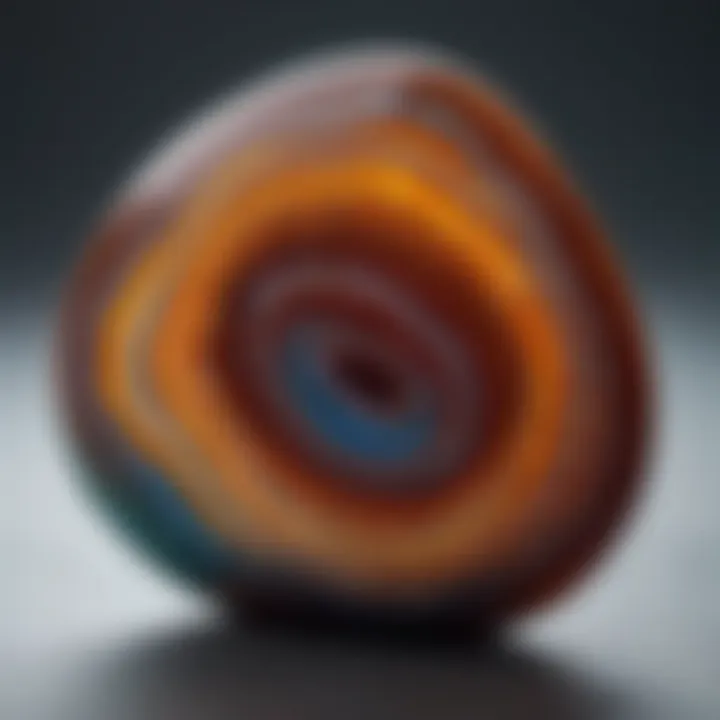
Intro
Identifying agate rocks can be both a rewarding and intellectually stimulating pursuit. Agate is not just a single kind of mineral but rather a variety of chalcedony, which itself is a form of quartz. Its formation involves the intricate process of mineral deposition in volcanic rocks or gas cavities, leading to stunning banded appearances that are often sought after by collectors. As a unique geological specimen, agate presents numerous variations in color, pattern, and texture.
This guide aims to equip you with the essential tools and knowledge to identify agate effectively. Whether you are an aspiring enthusiast or an experienced collector, understanding the unique features of agate and differentiating it from related minerals is crucial. This article breaks down the process into digestible sections and key points that will enhance your appreciation for agate and refine your identification skills.
Featured Collectible of the Month
Overview
Each month, we spotlight a unique collectible that can spark interest and excitement among rock and fossil collectors. For this month, we focus on agate, a timeless specimen known for its striking colors and patterns.
Agate comes in many forms, from the commonly found banded types to rare varieties such as moss agate and lace agate. These stones can vary dramatically in appearance, enhancing their appeal to both hobbyists and serious collectors.
Historical Significance
The historical importance of agate dates back to ancient civilizations. Various cultures considered agate a protective stone, believed to ward off evil spirits. It was widely used in jewelry and ornamentation, often found in Indian, Egyptian, and Greco-Roman artifacts. Moreover, artisans valued agate for its workability and aesthetic qualities, leading to intricate carvings and decorative items.
As the understanding of geology has evolved, enthusiasts have come to appreciate agate not only for its beauty but also for the geological processes that created it. Its inclusion in scientific discussions and its relevance in cultural history serve to deepen the collector’s experience.
Identification Techniques
Visual Characteristics
To identify agate, one must first learn to recognize its visual characteristics. Here are some features to consider:
- Color Variations: Agate can exhibit a wide range of colors, including reds, blues, greens, and browns, often appearing in distinct bands.
- Banded Patterns: One of the most recognizable traits of agate is its horizontal or circular banding, which can vary in thickness.
- Translucency: While some agates may appear opaque, many are semi-transparent and allow light to pass through, revealing their inner beauty.
- Texture: Surface texture can range from smooth to slightly pitted, often giving hints about its formation environment.
Resources for Identification
To further refine your identification skills, consider utilizing the following resources:
- Wikipedia: For general knowledge about agate and its properties. Visit Wikipedia Agate.
- Encyclopaedia Britannica: Offers detailed articles related to geology and mineral identification. Check it out at Britannica Agate.
- Online Communities: Reddit and Facebook groups dedicated to rock and fossil collecting can provide real-time feedback and advice for identification.
By understanding the unique characteristics of agate and where to find reliable information, hobbyists can confidently engage with this captivating mineral. The subsequent sections will delve deeper into the process of identification, helping you to appreciate not only the aesthetic qualities of agate but also the scientific principles behind its formation.
Preamble to Agate Rocks
Understanding agate rocks is significant for both enthusiasts and serious collectors. Agate is not just another mineral; it represents a fascinating aspect of geology and offers insights into Earth's history. Collectors often seek agate due to its unique aesthetics and variety. This uniqueness lies in its banded patterns and colors, which are a result of geological processes that have occurred over millions of years.
The importance of recognizing agate rocks can’t be overstated. For a collector, the ability to identify agate accurately contributes to the overall value of their collection. Knowledge about different types of agate and their characteristics allows collectors to make informed decisions. Moreover, understanding agate can deepen appreciation for geology, as it links to larger processes that have shaped our planet.
Definition and Geological Significance
Agate is a variety of chalcedony, which is a form of silica. It is characterized by its fine-grained texture and the presence of bands or layers of color. These color bands are often formed by the deposition of minerals in the cavities of volcanic rocks. The geological significance of agate lies in its formation process, which can provide clues about the environmental conditions present during its formation. The study of agate can reveal much about the geological history of an area.
Historical Context of Agate
Throughout history, agate has been valued for its beauty and perceived properties. Ancient civilizations used agate for tools and ornaments, with examples dating back to the Neolithic period. In various cultures, agate stones were admired not only for their physical attributes but also for their believed metaphysical qualities. Sailors, for instance, carried agate for protection against storms. Today, agate continues to hold cultural significance, finding its way into jewelry and decorative pieces. Understanding this history enriches a collector's experience, connecting them to past traditions and uses of agate.
Importance in Collecting
Agate is highly sought after in the collecting community. Collectors appreciate both the aesthetics and the story behind each piece. Different types of agate, such as Sardonyx or Moss Agate, have distinct features that appeal to varied tastes. Additionally, agate’s availability in many locations around the world means that collectors can find local specimens, creating a connection to their geographic area. By focusing on ethical collecting practices, individuals can contribute positively to the preservation of natural resources. Overall, collecting agate is not only a hobby but also an avenue for learning and appreciation of natural history.
Physical Characteristics of Agate
Understanding the physical characteristics of agate is essential for proper identification. These unique features serve as primary indicators that set agate apart from other minerals. By recognizing these properties, collectors can enhance their skills in distinguishing various types of agate and appreciate the nuanced beauty of these specimens. The physical attributes of agate encompass color variations, translucency, and luster, each contributing to its overall identity.
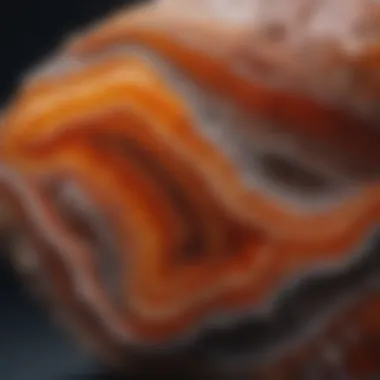
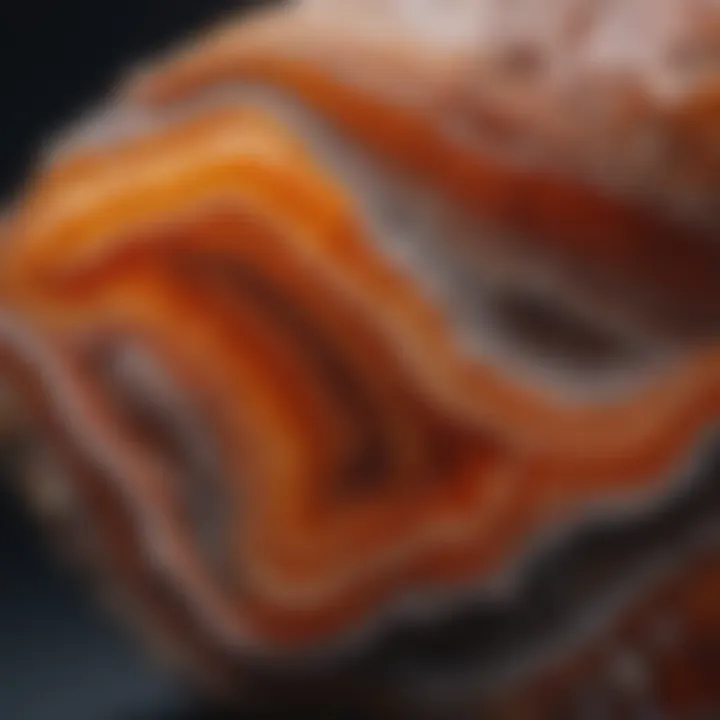
Color Variations
Agate exhibits an array of color variations that can range from vibrant reds, deep blues, soft greens, and neutral shades like browns and grays. One of the most distinctive features is its banding patterns, which can be seen in many specimens. These bands are often formed due to the layering of silica-rich materials during its geological formation. Collectors should pay close attention to how the colors can fade or blend within these bands, as this is a hallmark of agate.
Different types of agate, such as random color bands or specific formations like striped patterns, provide insight into the geochemical environment from which they originated. Additionally, encountering inclusions or different mineral deposits within the agate can also lead to unique color transformations.
In evaluating color, consider the following points:
- The intensity of the colors and how they interact with light.
- The presence of any inclusions that might alter the hue.
- How consistent the coloration is throughout the specimen.
Translucency and Transparency
Translucency and transparency are critical physical characteristics when identifying agate. Agate typically presents with a semi-translucent quality. This means that light can partially pass through the stone, allowing one to see certain features while others remain clouded. This property is essential in differentiating agate from opaque stones like jasper.
Collectors should observe the way the stone interacts with light. A higher level of translucency usually indicates higher quality agate, enhancing its aesthetic and market value. Check the following aspects when assessing translucency:
- Use a light source to observe how light passes through.
- Check for uniformity in transparency across the surface.
- Be aware of any varying degrees of opacity within the same piece.
Luster and Texture
The luster and texture of agate significantly add to its appeal and identification process. Agate generally possesses a waxy to glassy luster, which reflects light in a soft, appealing manner. This quality can vary from one specimen to another, creating a unique visual experience with each piece.
Texture plays a significant role in identification as well. Agate often has a smooth finish due to its mineral composition and polishing processes. However, some types, like moss agate, exhibit a more textured surface due to the presence of mineral inclusions. Assess the following factors when examining luster and texture:
- Touch the surface to determine its smoothness or roughness.
- Evaluate how the luster changes with different angles of light.
- Look for any natural imperfections or features that may contribute to its uniqueness.
Understanding these physical characteristics is fundamental in the identification of agate rocks, and recognizing them can greatly assist rock and fossil collectors in their pursuits.
Identifying Agate: Visual Inspection
Visual inspection is a crucial first step in identifying agate rocks, as it allows collectors to gather initial information about the sample in question. Agate exhibits distinct traits that can be apparent even to the untrained eye. Understanding these visual cues is key for enthusiasts and collectors who want to distinguish agate from other similar stones. This method does not require specialized equipment, making it accessible to anyone in the field.
Recognizing Banding Patterns
One of the most striking characteristics of agate is its banding. Banding patterns can vary significantly, showcasing layers that may be in different colors or translucent hues. The bands may be parallel or exhibit curves, giving each piece a unique appearance. To identify agate, closely observe these patterns, noting their width and color variations. A well-defined banding pattern is often a strong indicator that you are dealing with agate. Unlike some other minerals, agate’s bands typically form in varying thicknesses, which can serve as a helpful characteristic during identification.
Assessing Shape and Form
The shape of an agate rock is another critical factor in its identification. Agate generally forms in nodular shapes, often resembling small rounded masses or irregular shapes rather than flat surfaces. When assessing an agate piece, consider its overall form—whether it appears more spherical or more elongated. Additionally, pay attention to any natural fractures or inclusions within the rock, as these can offer insights into the type of agate. For instance, some forms of agate may display specific shapes associated with their geological origin or type.
Examining Surface Features
The surface of an agate can reveal much about its nature. Examine the textural features, such as whether the surface is smooth or rough. Some agates may even have a glassy sheen, while others might appear more matte. Look for any pits, striations, or markings. These surface characteristics not only help in the identification process but also add to the overall aesthetic of the stone. While inspecting the surface, also consider whether the piece feels heavy or light relative to its size. The weight can sometimes provide additional clues about the mineral composition.
"Visual inspection is often the first interaction a collector has with agate. Taking the time to observe details can lead to a rewarding experience in identification."
Utilizing Testing Methods for Identification
Identifying agate rocks goes beyond visual cues and requires practical testing methods. These tests help ensure accuracy when distinguishing agate from similar minerals. By applying systematic approaches, collectors can gain more confidence in their findings. Testing methods not only verify the initial identification but also serve educational purposes. Such hands-on experiences deepen understanding about the properties and characteristics of these fascinating stones.
Hardness Test
The hardness test is a vital method for assessing the resistance of agate to scratches. This particular test is based on the Mohs scale of mineral hardness. Agate typically falls between 6 and 7 on this scale. To perform the hardness test, one can use common materials, such as a fingernail, a copper coin, or a steel file. By attempting to scratch the surface of the agate with these items, you can determine how resistant the stone is to abrasion. If the nail does leave a mark, then the specimen is likely not agate. Conversely, if there is no change, then its hardness aligns with agate's typical characteristics.
Acid Reaction Test
The acid reaction test helps to distinguish agate from calcite or limestone, which can often be confused with it. Using dilute hydrochloric acid, one can apply a few drops to the stone’s surface. Agate, being a chalcedony variety, will not react to acid. In contrast, if bubbling or fizzing occurs, the stone may contain calcium carbonate. This reaction signifies the presence of another mineral rather than agate. Care should be taken when dealing with acids. Protective gear such as gloves and goggles is recommended to ensure safety during this process.
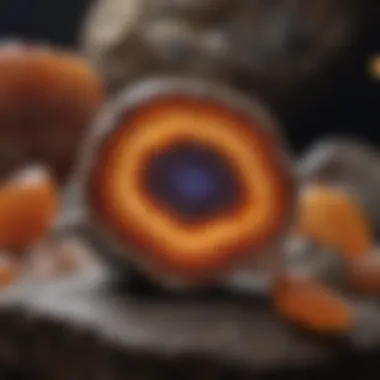
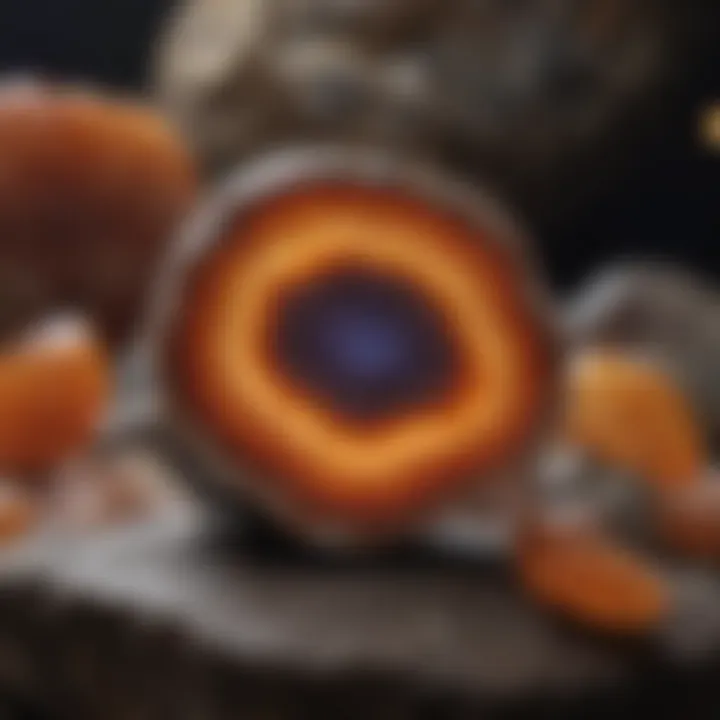
Specific Gravity Test
The specific gravity test measures the density of the sample compared to water. Agate typically has a specific gravity between 2.6 and 2.7. To perform this test, you would need a scale and a graduated cylinder. First, weigh the dry sample. Next, submerge the stone in water and find the difference in weight. The ratio of the weight in air to the weight in water provides a numerical value for specific gravity. This test can be beneficial when trying to differentiate between agate and other stones with similar appearances. Higher accuracy increases confidence in identifying agate when specimens appear similar at first glance.
Common Types of Agate
Identifying the various types of agate is a fundamental aspect of understanding this unique gemstone. Each type has distinct features and characteristics that can enhance both the collecting experience and the appreciation of agate within geological contexts. Recognition of these types allows collectors to make informed decisions when purchasing or trading agate specimens. Each variety exhibits its own beauty and appeal, contributing to their desirability among enthusiasts.
Sardonyx Agate
Sardonyx agate is recognized for its striking banding that typically features rich red and white layers. Unlike many other agates, sardonyx is often utilized in jewelry and decorative items, largely due to its aesthetic appeal. The material is durable and can be polished to an impressive shine, which makes it valuable for both collectors and artisans. Knowing how to identify sardonyx involves examining the smooth, curved bands and the range of colors; these traits set it apart from other agates.
Moss Agate
Moss agate distinguishes itself through its unique inclusions that resemble moss or foliage. This mineral is not a true agate but rather a variety of chalcedony. The green patterns are usually formed through mineral impurities and can vary significantly, making each piece distinctive. Understanding moss agate is important for collectors since its natural appearance and earthy undertones appeal widely. Its formation process also indicates how environmental factors influence geological development.
Crazy Lace Agate
Crazy lace agate is easily identifiable by its intricate, swirling patterns and vibrant color combinations. This variety is often characterized by its dynamic lines and contrasting hues, which can range from white to pink and yellow. The name reflects the chaotic appearance of its banding, attracting many collectors drawn to its visual complexity. Spotting crazy lace agate involves looking for these unique patterns and the notable texture that sets it apart from others.
Fire Agate
Fire agate stands out due to its unique iridescence and the play of colors that can appear in interesting ways when viewed from different angles. The internal patterns and surface structure often create visual effects that remind one of flames or embers, hence the name. Identifying fire agate requires close inspection of these effects, as well as an understanding of the environments where fire agate is typically found. This type is sought after for its captivating appearance and rarity, making it a favorite among both collectors and gemstone enthusiasts.
The identification of common agate types can greatly influence a collector’s choice in acquiring these geological specimens, enhancing both their collection and knowledge.
Similar Stones to Agate
Understanding similar stones to agate is crucial for anyone interested in rock and mineral identification. Identifying these stones helps collectors avoid confusion and misidentification. It expands knowledge about the mineral world and enables effective comparison with agate. This section details three minerals often mistaken for agate, providing insight on how to differentiate them.
Identifying Chalcedony
Chalcedony is a fine-grained silica mineral and a member of the quartz family. It is often confused with agate due to its similar composition. However, chalcedony has a more uniform appearance and lacks the distinct banding patterns found in agate. When identifying chalcedony, examine its color and translucency. Chalcedony typically displays solid colors without the bands characteristic of agate.
One notable feature of chalcedony is its smooth texture. Comparing its luster with agate can also be beneficial. A quick hardness test can help too; chalcedony registers a similar hardness (about 7 on the Mohs scale). Yet, chalcedony shows a specific gravity closer to 2.6, while agate is slightly higher.
Distinguishing Jasper
Jasper is another stone that may bear resemblance to agate, but it has distinct characteristics. Unlike agate, jasper is an aggregate of many minerals and is opaque rather than translucent. Its colors can vary from reds and browns to yellows and greens, often displaying unique patterns.
To distinguish jasper from agate, focus on its opacity. The lack of transparency is a key indicator. In addition, jasper does not exhibit the fine banding that agate is known for. When looking at surface features, you might notice that jasper often has a more dull and earthy appearance compared to agate's glossy finish. Keep in mind that jasper often has higher specific gravity, around 2.6 to 2.7.
Recognizing Onyx
Onyx is another stone commonly confused with agate, although it is somewhat easier to differentiate due to its layered structure. Onyx usually has straight banding that can be more pronounced than agate's wavy patterns. Its colors can vary from black and white to colorful variations, but the most common type is black onyx.
The key to recognizing onyx lies in its banding. Unlike agate, where the bands are often irregular, onyx presents straight, parallel layers. A visual inspection with a magnifying glass can help reveal this influe. Checking for translucency is vital, as onyx tends to be more translucent than many varieties of agate. When you conduct a hardness test, you will find that onyx showcases a similar hardness to agate but pay attention to specific gravity, which is slightly lower.
Understanding how to differentiate between agate and similar stones enhances your identification skills, ensuring accurate classifications for your collection.
Tools for Identifying Agate
Identifying agate rock specimens requires more than just visual observation. Utilizing the right tools significantly enhances a collector's ability to accurately classify and appreciate the nuances of agate. The essential tools not only simplify the identification process but also increase the accuracy of assessments. They help in detecting physical characteristics that the naked eye may easily miss, ensuring that collectors make informed decisions.
Magnifying Glass
A magnifying glass is a fundamental tool for anyone serious about identifying agate. With its simple design, it offers an affordable solution to magnify the features of agate. When examining agate through a magnifying glass, collectors can closely observe banding patterns and other unique textures that make each specimen distinct.
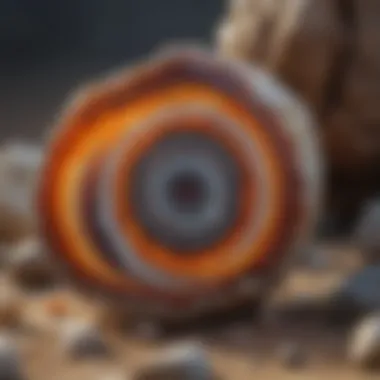

By using a magnifying glass, you can:
- Detect subtle color variations within the stone.
- Examine the clarity and inclusions, which can indicate the quality of the agate.
- Identify minute details that denote differences between agate varieties and similar stones.
This tool provides a practical way to expand your understanding of agate's intricacies, making it invaluable for both seasoned collectors and novices.
Loupes and Microscopes
While a magnifying glass is useful, loupes and microscopes take the examination a step further. A loupe, typically offering higher magnification, allows for a detailed analysis that aids in distinguishing between agate types. Loupes enhance the visibility of banding and color distribution—elements critical for identification.
Microscopes, on the other hand, can reveal features at a microscopic level. These instruments are particularly beneficial when:
- Assessing the mineral composition of agate, which is essential for classification.
- Studying the microstructure, which can provide insight into the agate's formation process.
- Differentiating between similar stones, as the features visible only under a microscope can clarify ambiguous specimens.
For any collector aiming to enhance their skills, investing in a decent loupe or a microscope is a worthwhile strategy that fosters a deeper understanding of agate and contributes to more precise identification.
Field Kits for Collectors
Field kits tailored for collectors present a comprehensive approach to identifying different kinds of rocks and minerals, including agate. These kits often combine several tools—like magnifying glasses, loupes, and basic testing equipment. Deploying a field kit allows collectors to conduct on-site inspections, ensuring that they fully utilize their resources when amidst the geological formations.
The benefits of using a field kit include:
- Portability, making it easy to carry during field trips or collecting expeditions.
- Having all essential tools on hand, which means no need to improvise with inadequate materials.
- Enhancing the collecting experience and increasing accuracy when identifying agate specimens in their natural settings.
Adopting field kits into your collecting practice encourages a methodical approach, helping to refine skills and deepen knowledge about agate rocks and their related types.
"Proper tools can transform a mere hobby into a profound journey of geological discovery."
Collecting Agate: Best Practices
Collecting agate can be a rewarding and enriching hobby for mineral enthusiasts and collectors. Engaging with this activity not only helps one appreciate the natural beauty of agate, but also provides opportunities for learning about geological processes. However, responsible collecting is essential to ensure the integrity of natural sites and the preservation of these stunning specimens.
Ethical Collecting Guidelines
When it comes to collecting agate, adhering to ethical guidelines is crucial. This means respecting the environment and local regulations that govern mineral and rock collecting. Here are important points to consider:
- Obtain Permission: Before collecting in any area, it's vital to check local laws and obtain permission if you are on private land. Many regions have designated areas for collecting, or may require permits.
- Stay on Trails: To minimize ecological impact, stick to established trails and avoid disrupting the surrounding ecosystem. This practice helps preserve the habitat and protects other natural formations.
- Only Take What You Need: Collecting should be done responsibly, taking only a few specimens per visit. Over-collecting can damage local habitats and reduce the availability of these beautiful stones for future collectors.
- Leave No Trace: After your collecting trip, make sure to clean up any materials you brought with you. This could include trash or leftover equipment. Your actions should not contribute to littering or environmental degradation.
"Practical ethics in collecting ensure that we can enjoy mineral hunting while preserving the beauty of nature for future generations."
Creating a Field Journal
A field journal serves as an excellent tool for agate collectors, documenting findings and experiences during collecting trips. Keeping detailed records can enhance knowledge and increase appreciation for agate's variety and geological significance. Here are elements to include in your field journal:
- Location Details: Note the specific sites where you collect agate. Include GPS coordinates or local landmarks to help you return to these spots in the future.
- Date and Weather Conditions: Document the date of your collection along with the weather. Weather can significantly impact the visibility and accessibility of certain areas.
- Description of Specimens: Write detailed descriptions of the agate pieces you collect. Include aspects like color, shape, patterns, and any unique features.
- Photographic Records: Taking photos of your finds can supplement written details. Visual documentation is useful for referencing and identifying specimens later on.
- Reflections on Experience: Beyond just the rocks, jot down your thoughts about the experience itself. This can include challenges faced, interesting interactions, or even new techniques learned during the collecting process.
Creating and maintaining a field journal cultivates a deeper connection to the hobby. This practice can help collectors track progress and foster a better understanding of agate's complexity and variations.
In summary, ethical collecting and diligent documentation play pivotal roles in the agate collecting journey. By practicing good stewardship of our natural resources, we ensure that future generations can also share in the joy of discovering agate in its varied forms.
Finale
Summary of Identification Techniques
Agate rocks are distinguished by their unique characteristics. The identification techniques discussed include visual inspection, testing methods, and the use of specific tools. Banding patterns, color variations, and surface features can help in recognizing agate. The hardness test, acid reaction test, and specific gravity test further confirm its identity. These approaches offer multiple ways to confidently identify agate among other similar stones.
"The right techniques allow collectors to not just identify agate, but to appreciate its beauty and geological history."
Additionally, the importance of effective tools, like magnifying glasses and field kits, cannot be understated. Collectors should always be equipped to make accurate assessments during their pursuits.
Encouragement for Enthusiasts
While learning the ins and outs of agate identification may feel daunting, persistence pays off. Engaging with the agate community online and offline can provide valuable insights. Forums on Reddit or groups on Facebook can be especially helpful. Exploring local geology or joining clubs dedicated to rock collecting can deepen one’s appreciation of agate.
As you develop your skills, remember to document your findings in a field journal. This practice not only enhances your learning but also allows for reflection on your progress. Collecting rocks is not just an act; it is a journey that enriches knowledge and fosters connection with nature’s marvels.



